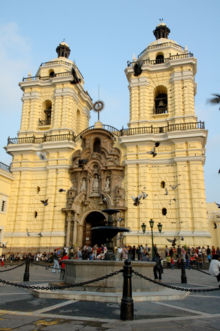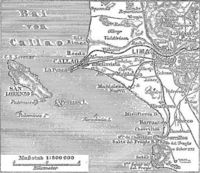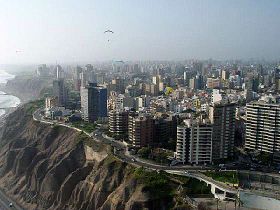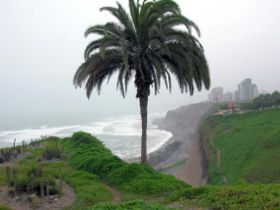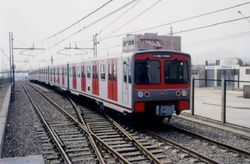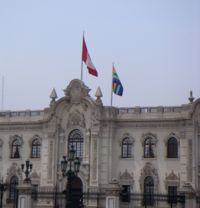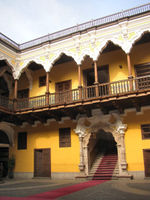Lima
2007 Schools Wikipedia Selection. Related subjects: Central & South American Geography
|
Lima |
|
|---|---|
| Location in Perú | Coat of Arms |
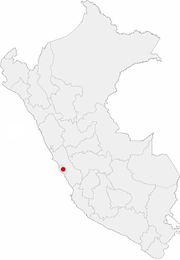 |
|
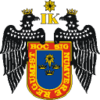 |
|
| City Flag | |
 |
|
| City nickname | La Ciudad de los Reyes
|
| Founded | January 18, 1535 |
| Government: | |
| - Region | Lima Metropolitan |
| - Province | Lima |
| - Mayor | Luis Castañeda Lossio |
| Area: | |
| - Total | 804.3 km² |
| - Subdivisions | 30 districts |
| - Latitude/ Longitude | 12°2.6'S 77°1.7'W |
| Population: | |
| - Total -Metro Area - Density |
6,872,766 8,187,398 8,544 km² |
| Demonym | limeño/a |
| City calling code | 1 |
| Time zone | UTC/ GMT-5 |
| Official website | www.munlima.gob.pe |
Lima is the capital and largest city in Peru, as well as the capital of Lima Province. It is the cultural, industrial, financial, and transport hub of the country. The city is located in an area encompassing the valleys of the Chillón, Rímac and Lurín rivers. It lies on a desertic coast adjacent to the bay in the Pacific Ocean where its port was built and named Callao.
Founded by Spanish conquistador Francisco Pizarro, Lima is also known as the City of Kings. For more than three centuries, Lima was the most important city and the greatest metropolis in South America. More than four centuries have passed since its founding as a Spanish city, and Lima has become an expression of Peru's heritage, with nearly one-third of the nation's population living in its metropolitan area.
While there is no formal administrative definition for the city of Lima, it is generally considered to be comprised of the central 30 out of the 43 districts of Lima province, corresponding roughly to the urban area centered on the historic Cercado de Lima district. The city serves as the core of the Lima Metropolitan Area, one of the ten largest metropolitan areas in the Americas.
The city was founded by conquistador Francisco Pizarro on January 18, 1535, naming it Tres Veces Coronada Ciudad de los Reyes as the location was decided at Epiphany, the January 6. Lima, its original name, however persisted. It is uncertain where the name originated, but it is thought that it derives from the Aymara word lima-limaq, (yellow flower) or from Quechuan rimaq (talking). In the oldest Spanish maps of Peru, both Lima and Ciudad de los Reyes can be seen together as the names of the city. The river that feeds Lima is still known to this day as "Rimac" which is thought to be the origin of the city's name, the "valley of the Rimac". The river is also nicknamed the "Talking river" (Río Hablador in Spanish).
Lima became the most important city in the Spanish Viceroyalty of Peru, which encompassed nearly all of Spain's possessions in South America during the colonial era (mid 1500s to early 1800s).
In 1746, many important and monumental buildings were damaged and or destroyed (later repaired) in an earthquake. The City of Kings' cultural patrimony and incomparable, beautiful architecture remained prevalent. Its architectural and political importance in Latin America were equalled only by Mexico City.
In 1996, the Japanese embassy hostage crisis took place in Lima, an affair which received global media attention. It ended on April 22, 1997 when Peruvian Armed Forces commandos stormed the building by carrying out a frontal daytime attack after tunneling underground into the embassy to rescue the seventy-two hostages. One hostage died of medical complications, two soldiers.
Demographics
The Lima Metropolis ranks among Latin America's largest and densest urban concentrations, with estimated populations (as of 2005) of 6.9 million for the urban area, 7.4 million for the entire province, and 8.2 million for the metropolitan area. The population of Lima features a very complex mix of racial and ethnic groups. Traditionally, Mestizos, Peruvians of mixed Spanish and Amerindian descent, have been the largest contingent, making up much of the middle class. However, political and economic instability of Peru during the latter half of the twentieth century created unprecedented poverty and violence in the towns of the countryside Andean or highlands, forcing hundreds of thousands of peasants of full-blooded Amerindian descendants to migrate to Lima, thus greatly augmenting the Lima's population. Unlike other ethnic groups that live in Lima and only speak Spanish, most of the peasant population that migrated to Lima speak primarily Quechua or Aymara before Spanish, rather than Spanish. While a number of Amerindians eventually attain middle class status, others still live in shantytowns, locally known as pueblos jóvenes (young towns). These areas often lack such basic services as electricity and running water. It is expedcted, that over the next ten years, the population of these shantytowns will diminsh to 8% of the population of Lima. Europeans, the economically dominant segment of the population, are mostly of Spanish descent, but there are significant numbers of Italians, Germans and others. Afro-Peruvians, initially brought to the region as slaves, are yet another important part of the city's ethnic quilt. Finally, during the 20th century, Lima also gained signicant Asian communities, particularly of Japanese and Chinese ancestry. The former constitute the largest Japanese concentration in South America after São Paulo.
The racial demographics for the city of Lima are:
- 50% Mestizo (mixed European and Ameridian ancestry)
- 29% Amerindian
- 85% Quechua
- 15% Aymara
- 15% White
- 65% Spanish
- 35% Italian, German, or other European ancestry
- 3% Black
- 3% Asian (Mainly from Japanese and Chinese descent)
Geography
Physical setting
The city of Lima (urban area) covers about 800 km². It is located on mostly flat terrain in the Peruvian coastal plain, within the valleys of the Chillón, Rímac and Lurín rivers. The city slopes gently from the shores of the Pacific Ocean into valleys and mountain slopes located as high as 500 mASL. As in the rest of the region, the extreme dryness of the climate means that away from the river valleys and irrigated areas the local terrain is absolutely barren of vegetation. During extreme El Ninos or unusually wet winters, patchy short vegetation may develop in some of the mountains located immediately to the east of the city as part of the coastal "lomas" ecosystem, but these green slopes are not evident, since they may be hidden within the grayish barren landscape.
Climate
Lima's climate is quite mild, despite being located in the Tropics. The average low temperatures range from 58°F (14°C) to 68°F (20°C) and the highs average around 78°F, with 32°C (90°F) considered extremely high. While these temperatures are generally thought of as mild and comfortable in other places, because of the narrow range on the thermometer, the locals think of these lower temperatures as very cold and the warmer temperatures as very hot.
Relative humidity is very high, and produces brief morning fog from December to June and persistent low clouds from May to November. Sunny, moist and warm summers (Dec-Apr) are followed by cloudy, damp and cool winters (Jun-Oct). Rainfall is almost unknown. The yearly average of 0.7cm (0.3in) reported at the airport is the lowest of any large metropolitan area in the world. Inland locations receive 1 to 6 cm of rainfall, which accumulates mainly during the winter months. Summer rain occurs in the form of isolated light and brief afternoon or evening events, leftover from afternoon storms that generate over the Andes. The peak of the 'rainy season,' which really does not apply, occurs during winter when late-night/morning drizzle events (locally called 'garúa','llovizna' or 'camanchaca') become frequent. All these climatic phenomena arise from the combination of semi-permanent coastal upwelling and the presence of the cold Humboldt Current just offshore.
Districts and neighborhoods
Lima city proper is generally considered to be comprised of the densely-populated, thirty central districts of Lima Province. Each district is headed by a mayor, although the Metropolitan Lima Municipal Council (Municipalidad Metropolitana de Lima), led by the mayor of Lima, also has authority in these districts, including the thirteen outer districts of Lima province.
The historical downtown of the city is located in the Lima District, which is locally known as Cercado de Lima. This is where most vestiges of Lima's colonial heyday remain, as well as the Presidential Palace and the Metropolitan Lima Municipal Council.
The neighborhoods of Miraflores and San Isidro are among the wealthiest in the city with most of Lima's upscale hotels and other tourist destinations located in them. The latter district is also an important financial centre that is nowadays far more important in Lima's daily business life than the Cercado. The districts of La Molina, San Borja and Santiago de Surco offer quieter, residential areas.
Barranco, south of Miraflores, is known as a bohemian neighbourhood and has earned recognition for its population of writers and intellectuals.
The most populous districts of Lima lie in the north and south ends of the city. Their population is comprised principally of immigrants from other regions of Peru. Many of them are poor people of indigenous origin who arrived during the mid and late twentieth century after being displaced by terrorism, agrarian crises, and general economic frustration. These peasants invaded the vast desert areas and hillsides in the districts of the Cono Norte and Cono Sur areas, populating new slums known as pueblos jóvenes. The majority of the people are poor and live in slums with no electricity and running water.
In recent years, however, these populous districts and the people living in there are becoming wealthier at a slow pace, and the amount of business operations being performed in there has steadily increased. It is common knowledge that if anybody wants to make money, the northern districts are the place to do it.
Education
Universities
The city has the largest concentration of higher-education institutions in the country. The National University of San Marcos, founded on May 12, 1551 during Spanish colonial regime is the oldest continuously functioning university in the Americas and considered by many Peruvians "La decana" in the sense of " dean of universities" across Peru.
The Pontificia Universidad Católica del Perú is the oldest private university (established on 1917). Other notable private institutions that are located in the city are Universidad del Pacifico, UPC and Cayetano Heredia University.
Other state owned universities also play key roles in teaching and research, such as the Universidad Nacional de Ingeniería, Universidad Nacional Federico Villarreal and Universidad Nacional Agraria La Molina, but the Universidad Nacional de Ingenieria (National University for Engineering) is regarded as one of the most prestigious universities for science and engineering careers in the country and probably one of the hardest to be admitted to.
These universities are highly especialized for some careers, for instance, for humanities the Universidad Mayor de San Marcos, for Law studies the Pontificia Universidad Catolica del Peru, for medicine, the Univesidad Nacional Cayetano Heredia, for Business and Economics, the Universidad del Pacifico and for Sciences and Engineering, the Universidad Nacional de Ingenieria mostly known as UNI.
Libraries
Founded by José de San Martín, Peru's oldest and most important library, the National Library of Peru is located in downtown Lima. As it has suffered wars and earthquakes throughout history, a new location for the library has been built in the San Borja district, with transfer of the library's holdings beginning in March of 2006. This modernization program aspires to turn the library into one of Latin America's most modern libraries.
Commerce and industry
Lima has substantial textile, paper, paint, and food products industries.
In recent decades, Lima has rapidly expanded and the city has seen much unregulated development. In the last decade, air pollution has risen to alarming levels, as no restrictions are allowed on the age or efficiency of motor vehicles. Leaded petrol is no longer sold however.
The " Estadio Monumental "U"", located in Lima, is Peru's largest and most modern stadium; it seats eighty-thousand spectators.
Transport
Lima does not have a public bus system. Private busses, commonly known as micros or combis, are very cheap but their routes are confusing especially to foreigners. Combis are often crowded and poorly maintained.
Taxis vary in quality of service and price. They can be stopped at any street, or private taxi companies can be called to pick up passengers at a certain address.
Numerous inter- urban bus companies offer transportation to other cities in Peru. Quality varies depending on the price, from luxury express buses to uncomfortable and crowded micros.
Nowadays Lima's mayor is working on a new bus system called Metropolitano where all buses will have exclusive lines; it has been told that new buses must be acquired by the companies working in the metropolitan area, this busses will be bought from a Chinese company, the same company that sells buses to Italy. The mayor's hope is to see a new massive transport system in the next few years.
To improve the quality of taxis running in Lima, a new law has been promulgated forbidding the importation of used cars; the city of Lima hopes that this law will promote the use of newer cars in the city, reducing vehicle emissions and smog.
An agreement signed by Mayor Luis Castañeda and President Alejandro Toledo on February 17, 2005, provided funding for finishing the Lima Metro, an above-ground mass-transit system which will link the downtown area with the financial district, San Isidro. The project was launched in the late 1980s but left unfinished by former president Alan García.
Lima's main passenger gateway for national and international air travelers is Jorge Chávez International Airport. International travelers should know that check in for most airlines are three and a half hours before take off.
Tourist attractions
The Historic centre of Lima, located in downtown Lima and the Rímac District, was declared a UNESCO World Heritage Site in 1988 due to the large number of historical buildings dating from the Spanish colonial era, a small number of which have now been restored. In particular, the monumental Plaza Mayor, with the 16th century Cathedral and the Presidential Palace, and the catacombs of the Convento de San Francisco are popular with visitors.
Several sections of the Lima City Walls can still be seen. These fine examples of Spanish medieval fortification were used to defend Lima from attacks from pirates and corsairs.
The city also has a number of fine museums, notably the National Museum of Anthropology, Archaeology, and History and the Rafael Larco Herrera Archaeological Museum, both in the Pueblo Libre district.
Many small beaches, which are heavily visited during the summer months, are located by the southern Pan-American Highway. The most well-known ones are located in the districts of Santa María del Mar, Punta Hermosa, Punta Negra, San Bartolo and Pucusana. Also, the district of Ancón, located north of the city, has a very popular beach resort.
Numerous restaurants, clubs and hotels have been opened in these places to serve the many beachgoers. The beaches in Lima itself are not suitable for swimming because the city's sewage is dumped raw into the ocean.
The suburban district of Cieneguilla and the town of Chosica (in the Lurigancho District) provide attractive green landscapes at a short distance from the city. Because of their elevation (over 500 meters), the sun shines in these areas even during winter and hence they are visited by residents of Lima to escape from the winter fog.
Recently, the Palomino Islands near the port of Callao have attracted visitors due to a population of sea lions.
Situated in Monterrico, the Gold Museum, together with the even more interesting textile museum. Here can be seen almost perfectly preserved thousand year old garments and feathered capes recovered from the waterless deserts of Western Peru. Also in the same building, an arms museum with a huge range of antique Spanish firearms, among muskets and arquebuses.
Sites of interest
- Historical Centre of Lima
- Beaches and Waterfront
- Ancón
- Barranquito
- Aguadulce
- Los Pavos
- Las Cascadas
- Las Sombrillas
- Costa Linda
- Paracas
- Museums
- Gold Museum
- Lima Wall Museum
- Museum of the Nation (Museo de la Nación)
- Japanese Inmigration Museum
- National Museum of the Archaeology, Anthropology, and History of Peru (Museo Nacional del Arqueología, Antropología, e Historia del Perú)
- Natural History Museum, Lima (Museo de Historia Natural)
- Arts & Peruvian Popular Traditions Museum
- Miguel Grau House-Museum
- Ricardo Palma House-Museum
- Morro de Arica soldiers Museum
- Italian Arts Museum
- Congress and Inquisiton Museum
- Colonial Buildings
- Justice Palace
- Rimac Building
- Governor's House
- Lima's Cathedral
- Saint Lorenzo Church
- Saint Rose of Lima Church
- Congress of the Republic
- Lima's Mayor House
- Segura Theatre
- Italian Arts Museum
- Lima's Art Centre
- Lima's City Walls Park
- Torre Tagle Palace
- Acho Plaza
- Saint Martin Plaza
- National Culture Institute
- University Park
- Desamparados Train Station
- Rosa Nautica Restaurant
- Perez Aranibar Children House
- Naval Heroes Park
- Islands
- San Lorenzo Island
- Amusement Parks
- Lima's Zoo, San Miguel
- Kart Circuit, Magdalena del Mar
- Daytona Park, Surco
- Sports Centre, Miraflores
- Apolo (Ice-Skating Park), San Isidro
- Lima's Hippodrome, Surco
- La Granja Villa, Chorrillos
- Sports Centre, Barranco
- Zoos
- Parque de las Leyendas
- Centro Ecologico Recreacional de Huachipa
Notable people born in Lima
Artists
- Felipe Pinglo Alva, father of Peruvian Musica criolla
- Susana Baca, Grammy award- winner folk singer
- Eva Ayllon, first-class "criollo" (folk music) singer, she is trying other styles (jazz, blues, salsa) with distinct success
- Juan Diego Florez, world recognized tenor, a possible successor to Pavarotti, in the maestro's own words.
Historical
- Saint Rose of Lima ( April 20, 1586- August 30, 1617) Patron Saint of America, first Roman Catholic saint born in the Americas.
- Saint Martin of Porras
- Saint Turibius of Mongrovejo, Archbishop of Lima
Politicians
- Javier Valle Riestra, lawyer and politician
- Javier Pérez de Cuéllar, first Latin American to become Secretary-General of the UN.
Sportspeople
- Teófilo Cubillas, football (soccer) player
- Jefferson Farfán, football (soccer) player
- Luis Horna, tennis player
- Jean Carlos Gamarra, taekwondo player
- Sofia Mulanovich, world champion surfer
- Claudio Pizarro, football (soccer) player
- Nolberto Solano, football (soccer) player
- Cecilia Tait, volleyball player
- Jaime Yzaga, tennis player
- Roberto Palacios, football (soccer) player
- Jean Pierre Saux, football (soccer) player
Journalists
- Jaime Bayly, Tv journalist and writer.
- Cesar Hildebrandt
Writers
- Mario Vargas Llosa
- Alfredo Bryce Echenique, writer (novels, memories, and short stories), among which the renowned A world for Julius (in Spanish: "Un Mundo para Julius".)
- Julio Ramón Ribeyro, writer best known for his short stories, and awared in 1994 by the Juan Rulfo prize.
- Ricardo Palma, writer of "Tradiciones Peruanas"
- Jaime Bayly, writer, journalist, and media personality
Contemporary Musicians
- Pedro Suarez Vertiz, pop singer
- Líbido, indie rock band
- Mar de Copas, indie rock band
- Gian Marco, pop singer and composer
- Arena Hash, pop band
- Campo de Almas, indie pop band
- Fragil, rock pop band
- Leusemia aka Leuzemia, progressive rock band
- Inyectores aka G3, punk rock band
- Diazepunk, punk rock band
- La Sarita, folk rock band
- Rafo Raez, rock singer and composer
- Dolores Delirio, indie rock band
- Daniel F, rock singer and composer (also Leusemia's vocalist and considered by some people as the best peruvian composer in the present time)
Reality TV Stars
- Johanna Botta, on shows such as Real World and Real World/Road Rules Challenge
